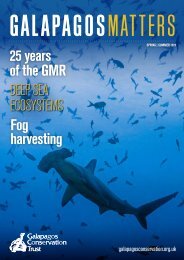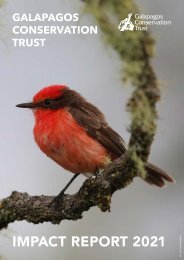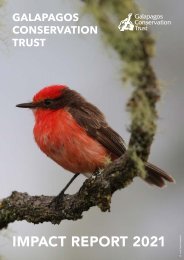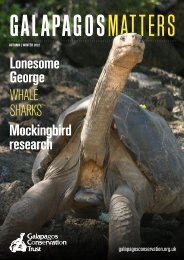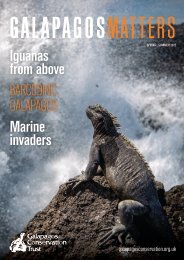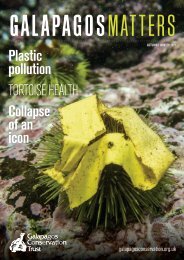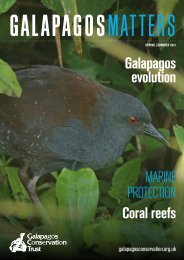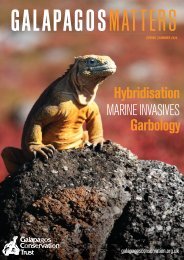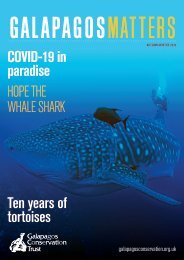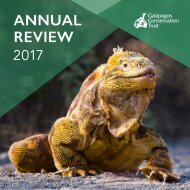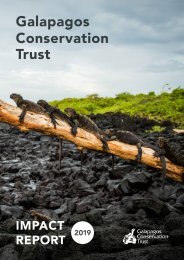2020 Impact report 2020 - Galapagos Conservation Trust
Create successful ePaper yourself
Turn your PDF publications into a flip-book with our unique Google optimized e-Paper software.
© Giant Tortoise Movement Ecology Programme<br />
THE GIANT TORTOISE<br />
MOVEMENT ECOLOGY<br />
PROGRAMME<br />
is studying these iconic species’ ancient<br />
migration routes and early years’ movements<br />
to inform conservation strategies.<br />
• 21 hatchlings tagged with radio transmitters.<br />
• Baseline health samples have now been<br />
collected from 600 individual tortoises.<br />
• A visit to Alcedo volcano, Isabela went ahead<br />
in December <strong>2020</strong> - 8 out of 11 tagged<br />
tortoises on the volcano were found, including<br />
Spikey, a female tortoise that had not been<br />
seen since 2016.<br />
Over the last three months, no<br />
field conservation activities were<br />
conducted in <strong>Galapagos</strong>. We could<br />
not conduct any education/outreach<br />
activities either. However, this<br />
break allowed us to regroup and<br />
reconsider some of our priorities<br />
and methodologies. I had time to<br />
focus on data and analyses. It was<br />
a very valuable time to re-evaluate<br />
our work and improve some methods<br />
for future activities.<br />
– Dr Ainoa Nieto, Wildlife Veterinarian<br />
and Researcher at the Charles Darwin<br />
Foundation, and researcher for the<br />
Giant Tortoise Movement Ecology<br />
Programme. July <strong>2020</strong><br />
© Joshua Vela Foncesca<br />
• 100 children aged 6-11 took part<br />
in tortoise outreach activities to<br />
learn more about <strong>Galapagos</strong><br />
THE LITTLE VERMILION<br />
FLYCATCHER PROJECT<br />
OUR LAND BIRDS OF<br />
GALAPAGOS PROGRAMME<br />
includes work to conserve the Critically<br />
Endangered mangrove finch, and the little<br />
vermilion flycatcher which was once common<br />
but is now classed as Vulnerable.<br />
The Mangrove Finch Project continues its work<br />
to protect the Islands’ most endangered bird<br />
species, driven to the brink of extinction by<br />
parasitic larvae of the invasive fly, Philornis<br />
downsi, which suck the blood of nestlings.<br />
• Population estimates remain at around<br />
100 individuals.<br />
was launched in 2019. This brightly coloured endemic<br />
songbird is declining at an alarming rate, threatened<br />
by invasive species and habitat degradation.<br />
• Most successful breeding season yet for the<br />
little vermilion flycatcher as 6 chicks successfully<br />
fledged their nests on Santa Cruz, where it is estimated<br />
that there are no more than 40 breeding pairs.<br />
• By October, all 6 project areas had been cleared of<br />
invasive blackberry plants and were showing<br />
regeneration of native vegetation, especially Scalesia trees.<br />
• After placing rat bait stations in the 6 plots in October<br />
2019, only 9% of nests failed due to predation in<br />
comparison to 22% of nests outside of the controlled<br />
plots in the <strong>2020</strong> breeding season.<br />
• There was a 40% increase in the number of<br />
breeding pairs recorded to 14 from 10 in 2019.<br />
• It is unknown whether any nests were successful<br />
in <strong>2020</strong> breeding season or if any chicks fledged<br />
as the team had to leave the field 5 weeks<br />
early due to the lockdown in <strong>Galapagos</strong>.<br />
Our Partners Delivering Projects in <strong>2020</strong><br />
Endangered Sharks of <strong>Galapagos</strong> – <strong>Galapagos</strong> Whale Shark Project,<br />
MigraMar, Universidad de San Francisco de Quito (<strong>Galapagos</strong> Science Center)<br />
Giant Tortoise Movement Ecology Programme – Charles Darwin Foundation,<br />
Ecology Project International, <strong>Galapagos</strong> National Park Directorate<br />
Mangrove Finch Project – Charles Darwin Foundation, <strong>Galapagos</strong> National Park Directorate<br />
Saving the Little Vermilion Flycatcher - Charles Darwin Foundation,<br />
<strong>Galapagos</strong> National Park Directorate, University of Vienna<br />
Due to the pandemic, we had<br />
to unexpectedly leave the field<br />
in the middle of mangrove<br />
finch breeding season,<br />
meaning we were unable to<br />
protect this year’s fledglings<br />
from Philornis downsi.<br />
– Francesca Cunninghame,<br />
Mangrove Finch Project Leader<br />
© Charles Darwin Foundation<br />
Overall, I consider invasive species to<br />
be the biggest threat for the wildlife in<br />
<strong>Galapagos</strong>. While we work hard to find<br />
solutions to reduce the impact of invasive<br />
species already present, a big focus<br />
should be placed on reducing new arrivals.<br />
– Birgit Fessl, Coordinator of the<br />
<strong>Galapagos</strong> Land Bird <strong>Conservation</strong><br />
Plan at the Charles Darwin Foundation<br />
© Charles Darwin Foundation<br />
12





